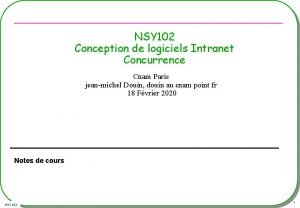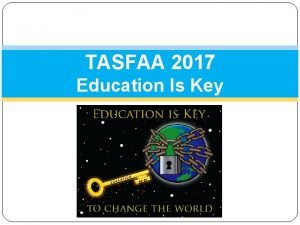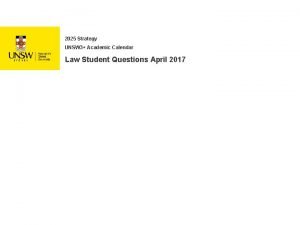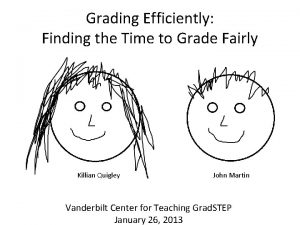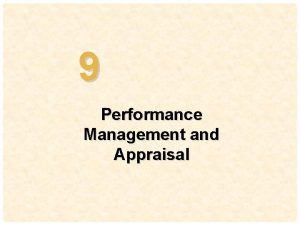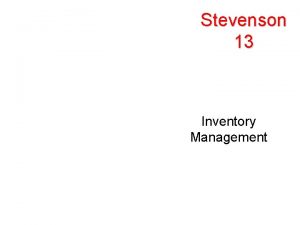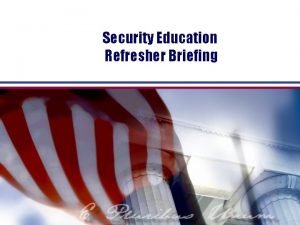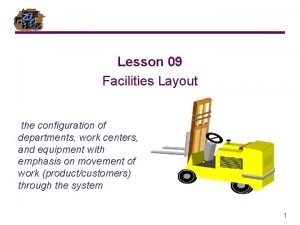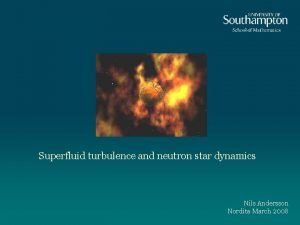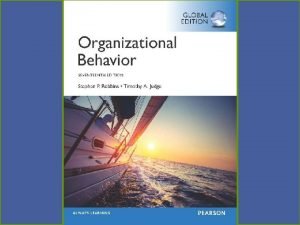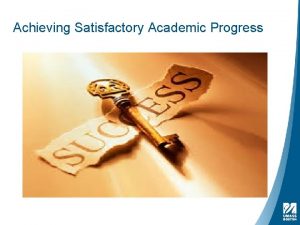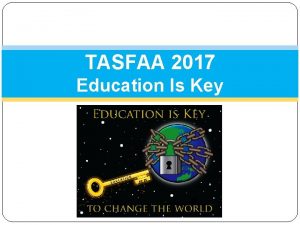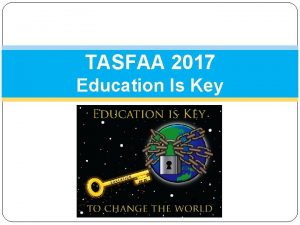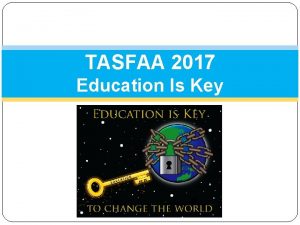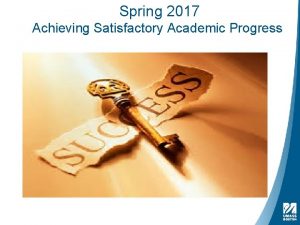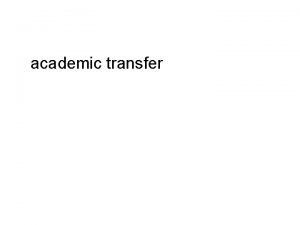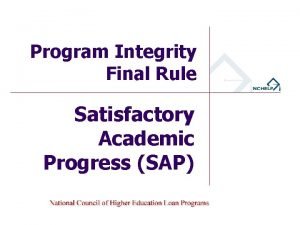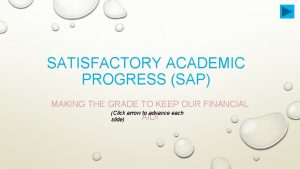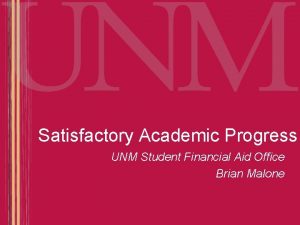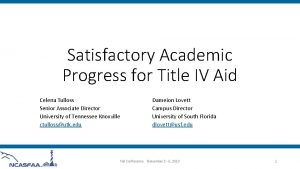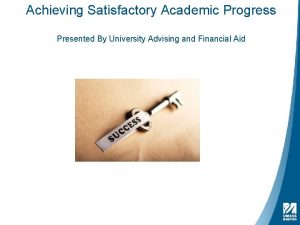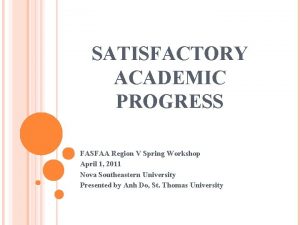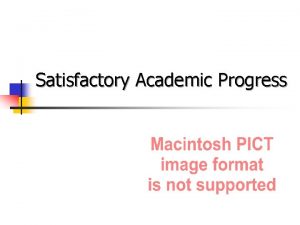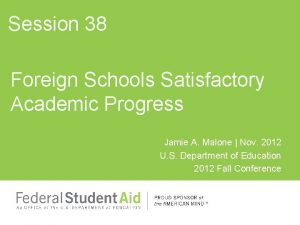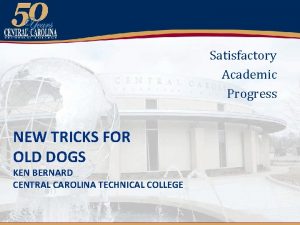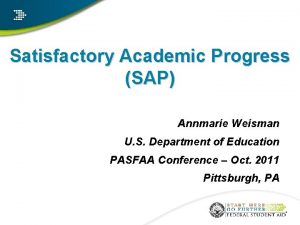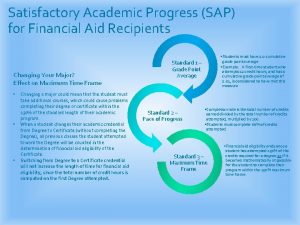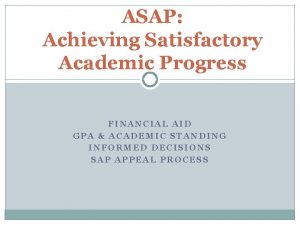TASFAA 2017 Education Is Key TCAT Satisfactory Academic






























- Slides: 30

TASFAA 2017 Education Is Key

TCAT Satisfactory Academic Progress Education Is Key April 23 -26, 2017

Information from 2011 USDE Training TASFAA 2017 Education Is Key

“Successfully Completes” • A student “successfully completes” clock-hours if your school considers the student to have passed the coursework associated with those hours TASFAA 2017 Education Is Key

• SAP policy required elements include § Describe how incompletes, withdrawals, repetitions, or transfers of credits impact SAP – Measurement of student’s progress at intervals • GPA that a student must achieve at each evaluation (qualitative standard) • Pace of progression to ensure completion within the maximum time frame (quantitative standard – cumulative earned hours vs. attempted hours) § More guidance and examples are coming on pace of progression for clock hour programs TASFAA 2017 Education Is Key

Maximum Time Frame § For undergraduate programs of study, must be no longer than 150% of published length of educational program § For clock hour programs, as measured in cumulative clock hours required to complete and expressed in calendar time § REMINDER § This simply addresses how long a student can take to complete the hours in the program it does NOT allow a school to pay Title IV aid for hours above the actual length of the program TASFAA 2017 Education Is Key

Maximum Time Frame Example • If the program is 1200 clock hours and meets 30 clock hours per week, that means the program is 40 weeks in length • 150% of 40 weeks is 60 weeks • A student may receive aid while enrolled in this program, for up to the point you determine the student cannot complete the program within 150% TASFAA 2017 Education Is Key

How Often Is SAP Evaluated? • For programs of study that are one academic year or less in length, school must evaluate SAP at end of each payment period • For programs of study longer than one academic year – School must evaluate at least annually to correspond with end of a payment period TASFAA 2017 Education Is Key

When is SAP Evaluated? • For clock hour programs, the SAP evaluation must be done at the end of a payment period – See June 6, 2011 Electronic Announcement • The evaluation can be at the end of every payment period or once a year (depending on program length), but it must be assessed at the end of the payment period – Remember that payment periods may not end neatly within your “TERMS” TASFAA 2017 Education Is Key

Electronic Announcement – 6/6/11 An institution may review a student’s academic progress in a program at the end of each payment period to determine if a student is eligible by selecting one of the following options for all students in a program: • At the point when the student’s scheduled clock hours for the payment period have elapsed, regardless of whether the student attended them; or • At the point when the student has attended the scheduled clock hours; or • At the point when the student successfully completes the scheduled clock hours for that payment period TASFAA 2017 Education Is Key

Disbursement of Funds Make certain that student meets satisfactory academic progress standards as of last time your policy required evaluation. TASFAA 2017 Education Is Key

Monitoring SAP Each Payment Period § In general, a student who is not making SAP is no longer eligible for Title IV aid § For an institution that chooses to evaluate SAP at the end of each payment period, a “financial aid warning” status may be used § Student may continue to receive Title IV aid for one payment period § No appeal necessary TASFAA 2017 Education Is Key

Monitoring SAP • If measure each payment period – – The payment period following a payment period in which the student did not make SAP, the school may: • Place the student on Financial Aid Warning; or • Place the student on Financial Aid Probation TASFAA 2017 Education Is Key

If student is given a Financial Aid Warning, he/she must make Satisfactory Academic Progress at the end of the next payment period to continue to receive financial aid. If the student does not make SAP, financial aid ends. There is NO appeals process. TASFAA 2017 Education Is Key

§ If institution does not have an appeal process, must describe how a student who has failed SAP can reestablish eligibility for Title IV aid TASFAA 2017 Education Is Key

Federal Student Aid Handbook 2016 -2017 Volume 1, Chapter 1 TASFAA 2017 Education Is Key

TASFAA 2017 Education Is Key

TASFAA 2017 Education Is Key

TASFAA 2017 Education Is Key

TASFAA 2017 Education Is Key

TASFAA 2017 Education Is Key

TASFAA 2017 Education Is Key

TASFAA 2017 Education Is Key

TCAT Financial Aid Handbook TASFAA 2017 Education Is Key

SATISFACTORY PROGRESS FOR FINANCIAL AID A. To make satisfactory progress a student must: 1. Complete 75% of cumulative scheduled hours (pace of completion). All periods of enrollment for a student’s program will be included in determining the cumulative scheduled hours used for SAP, regardless of receipt of Title IV aid for the prior enrollments. 2. Must maintain a minimum cumulative passing grade of “C” or higher if specified by the program and as published by the institution. CFR 668. 34 B. Satisfactory progress will be evaluated at the expected end of a student’s payment period. If the student fails to make satisfactory progress, the student will be placed on financial aid warning for the next payment period. If the student fails to make satisfactory progress for the next payment period, financial aid will be suspended. There is no appeals process for financial aid satisfactory progress. In order to reestablish financial aid, a student must make satisfactory academic progress at the next evaluation date. TASFAA 2017 Education Is Key

C. D. Remedial Courses – Any courses considered ‘remedial’ are included in the student’s normal program of study and are included in the students SAP calculation. Program Changes - Changes in program will not affect SAP because a student will then have a new program length and new payment periods. sfer E. institutions, life experience, work credit, dual enrollment, etc. ) will have their program length reduced. A student that receives transfer credit will have a maximum timeframe calculated based on the reduced program length. F. Repeats Program Repeats – Any student who completes an entire clock hour program and later re-enrolls to take that same program again or to take another program may be paid for repeating coursework regardless of the amount of time between completion of the first program and beginning the same program or another program. Course Repeats (within 180 days) The repeated course grade will be counted along with the previously assigned grade. Repeated course hours will count toward total cumulative hours (pace of progression). TASFAA 2017 Education Is Key

G. Withdrawals will not impact a student’s satisfactory academic progress unless they return within 180 days. Reentry within 180 days – A student who withdraws from a clock hour or credit hour nonterm program and reenters within 180 days is considered to remain in the same payment period when he/she returns and, subject to conditions imposed by ED, is eligible to receive FSA funds for which he/she was eligible prior to withdrawal, including funds that were returned under R 2 T 4 rules. The repeated course grade will be counted along with the previously assigned grade. Repeated course hours will count toward total cumulative hours (pace of progression). Reentry after 180 days and transfer students – Generally, you must calculate new payment periods for a clock hour or credit hour non-term program for: * A student who withdraws and then reenters the same program at the same institution after 180 days, or * A student who withdraws from a program and then enrolls in a new program at the same institution, or at another institution within any time period. TASFAA 2017 Education Is Key

H. Maximum Time Frame (this is for maximum time frame only, cannot pay more than 100% of advertised program length) Students may continue to receive Title IV Financial Aid and State Aid at the pace of 75% or greater until they have been enrolled 133. 3% of their scheduled hours. For example: A full-time student enrolled in a 1296 hours (12 months) program progressing at a rate of 75% may take 1728 hours (16 months) to successfully complete the 1296 hours. I. Notification Students will be notified of any evaluations that impact eligibility of Title IV aid. Note: Students receiving the Wilder-Naifeh Technical Skills Grant may not appeal unsatisfactory progress. TASFAA 2017 Education Is Key

Survey – How do you determine SAP 1. Do you print a transcript for each student? Do you use the detailed or summary transcript? 2. Do you have the instructors complete a form for each student? 3. Do you use a SIMS Report? TASFAA 2017 Education Is Key

Questions? Contact Information Amanda Heath 901 -481 -4154 Amanda. heath@tcatcovington. edu TASFAA 2017 Education Is Key
 Nsy102
Nsy102 Tasfaa regional training
Tasfaa regional training Tasfaa
Tasfaa Tasfaa
Tasfaa Unsw calender
Unsw calender Rating committee performance appraisal
Rating committee performance appraisal Fairly satisfactory grade
Fairly satisfactory grade Paired comparison method of performance appraisal
Paired comparison method of performance appraisal What would a satisfactory moral theory be like?
What would a satisfactory moral theory be like? Needs improvement
Needs improvement Objective of layout design
Objective of layout design Objectives of eoq
Objectives of eoq Highest level of classified information
Highest level of classified information Facilities layout
Facilities layout Abc classification system for inventory
Abc classification system for inventory Satisfactory slide glitch
Satisfactory slide glitch Business model example
Business model example Contoh bisnis model canvas makanan pdf
Contoh bisnis model canvas makanan pdf Collaborative on academic careers in higher education
Collaborative on academic careers in higher education Pearson education
Pearson education 2017 pearson education inc
2017 pearson education inc 2017 pearson education inc
2017 pearson education inc 2017 pearson education inc
2017 pearson education inc 2017 pearson education inc
2017 pearson education inc 2017 pearson education inc
2017 pearson education inc 2017 pearson education inc
2017 pearson education inc 2017 pearson education inc
2017 pearson education inc The education of adela 2017
The education of adela 2017 Pearson education 2017
Pearson education 2017 2017 pearson education inc
2017 pearson education inc Pearson education ltd 2017
Pearson education ltd 2017
